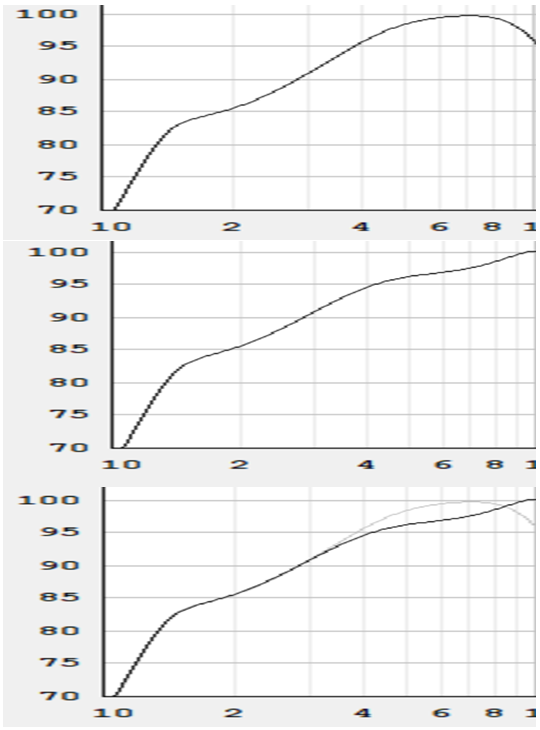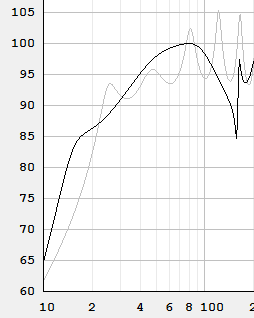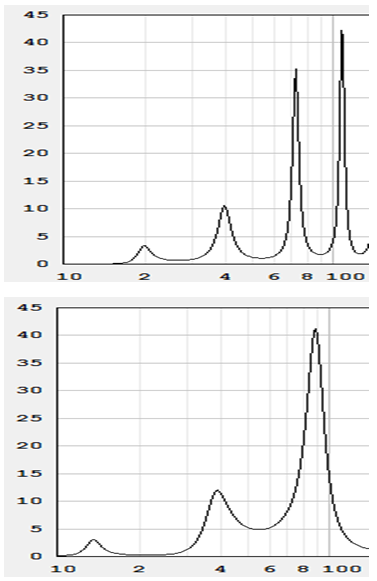
LTD02
Members-
Posts
9 -
Joined
-
Last visited
Recent Profile Visitors
The recent visitors block is disabled and is not being shown to other users.
LTD02's Achievements

Newbie (1/9)
28
Reputation
-
Hey guys, I saw there was some question about performance on the Devastator vs. a horn with an increasing flare. In order to shed some light on that one, I went ahead and modeled the Devastator and a second Devastator with an increasing flare rate (2:1 ratio for the mouth-to-throat cross-sectional area), approx. a 2:1 compression ratio, and the same size horn mouth. This isn't the only possible horn of course, but it is a decent starting point for seeing some of the issues involved. Both cabs have identical drive voltage 2.28 volts, which when considering the driver's DC resistance of 5.2 ohms, equals 1 watt of power. Simulation is 2pi space for both cabs as well. Below is the 1w1m response of both horns. Devastator is the one on top. It can be seen that the Devastator has greater output than the flared port horn from 50-80Hz, while the flared port horn has greater output above 85Hz. The second chart shows the efficiency of both cabs. Again, Devastator is the one on top. The Devastator's peak efficiency occurs at just over 80Hz, while the flared port horn peaks at about 100Hz. From these charts, the Devastator has greater output and efficiency up to about 85Hz. Since most folks are interested in bass from the teens on the low end up to about 100Hz on the upper end, the horn with zero flare offered superior performance across a larger portion of the frequency range of interest than the flared horn. The horn path on the Devastator was optimized for performance first. An unintended consequence of the optimization was that the horn path didn't require flaring. This made it super easy to DIY. If it was only easy to build, but didn't perform, it wouldn't have taken off like it did (either as a DIY project or as GSG flat pack kits). I've designed many horns over time, all with performance as the primary objective. 🙂 This one just so happened to be both optimized for performance and ease of construction, both at the same time. That rarely happens, but in this case it did. So, please don't feel like the Devastator is compromised with respect to performance simply because its flare rate is zero and is an easy build. Hope that helps. John
-
Kevin was able to get a decent measurement of the Devastator (w/LaVoce 21" SAN214.50) despite not having access to a large open area by placing the sub on its back in his driveway and suspending the mic over the cab. The response is quite close to our Hornresp model. Ignore level, only the shape of the curve is relevant in this one. The one that we sell is substantially similar to the one that I designed for the DIY community on AVS, so the DIY version will perform similarly.
-
Hi karlson3, In your post, you mention that the THTLP is about half the size of the Devastator. The measurements that I have indicate that the THTLP is actually a slightly larger cab. The measurements that I saw for the THTLP is 72" x 18" x 36", which is 27 cubic feet. The measurements for the Devastator are 48" x 24.75" x 30", which is about 20.7 cubic feet. I'm not sure if the models that you posted for the THTLP are all accurate. I'm not sure that mine are either! My understanding is that the THTLP is the THT in a different form factor, but with similar performance. If that is the case, then this is what I have. THT modelled 1w1m response using the 390HF driver. (Note: I am using drive voltage that based on each driver's DC resistance gives exactly 1 watt; and all models are 2pi space.) This model matches pretty well BFM's measurement of the sub, though BFM may have edited out some of the tips of the peaks in the blue line, though real horns tend not to have as strong of resonant peaks as Hornresp indicates. The locations of all the peaks are generally in the same regions (except the missing one around 170Hz), suggesting that the model is fairly reflecting the actual horn. With the same 1w1m, this is the comparison with the Devastator model. Maximum SPL based on 500 watts and 19mm excursion in the THT: (Note: the xmax on the 390HF is listed as 14mm, but that is overhang only. My guess is that usable excursion is up around 19mm or so, so that is what I used.) Maximum SPL based on 1700 watts and 19mm excursion in the Devastator: (Note: the driver was tested and has usable of just over 20mm, but distortion at that level is getting pretty high, so I used 19mm for the comparo.) We don't have a good place to measure the Devastator cab (first attempts were generating in-band cancellations from boundaries). Hopefully, we'll get some measurements posted soon! An important point is that THT was designed many years ago (before the era of the 21" superwoofers) and that the driver and recommended plate amp are less expensive than what is used in the Devastator, so in some sense this isn't really a fair comparison. But from a performance-only perspective, I think the models are reasonably capturing the differences between the two systems.
-
No problem. Shortly! :-) I'm not sure how long we are going to stay at these prices, but we don't have plans to raise them any time soon. Mostly doing this to provide a resource for the guys who are stuck in between being able to completely DIY subs and those who have the money to just buy commercial solutions. Well, we are also trying to create some interesting subs that might not otherwise come to market. I didn't take it that way. Several folks have asked what it is and there isn't a real clear answer. :-)
-
Hi babadono, While you are right that the Devastator cab is not a true horn in the eyes of many, what constitutes a true bass horn isn't actually well defined. I've attached a couple of simulations that may be helpful in understanding this design. Admittedly, simulations are not reality and measured results don't always conform to modeled results, but nonetheless they may be helpful in shedding some light on some key points, so here goes. In the first simulation, the black line represents one model of the devastator cab--with its non-flared 'horn section' and ported rear section. If we were simply to change the 'horn section' to have a flare that would make it look more like a traditional horn, the upper end shifts toward the light gray line. Output above 90Hz rises, but at the expense of output below 90Hz. On the low end, if the port is removed, output also falls. Those two effects together give the light gray line. Given that most folks who are running subs are looking for a good solution from about 20Hz to about 80Hz , we thought the design hit the target for that audience pretty well. The second simulation shows the efficiency (again, just a model) of a 390hf-loaded F20 horn (top chart) and a devastator model (bottom chart). the first efficiency peak occurs at different low frequencies owing to the different designs. The F20 has its first efficiency peak at 20Hz, while the devastator having a ported rear section has an efficiency minimum at about that point. Working up from there, both begin to rise in efficiency at 40Hz. The intermediate drop in the devastator is much less that that of the f20 owing in part to the enormous motor that is on the driver. Peak efficiency occurs at slightly different points, but overall the devastator seems to present a compelling efficiency case in the upper bass as compared with a traditional horn. All that efficiency translates into higher sensitivity too. The devastator has about 6dB greater 1w1m (2pi space, power based on dc resistance of driver) sensitivity in the upper bass as compared with the F20 and with its much more massive driver has greater output capability across the entire bass range (about +6dB or so on the low end to about 15dB or more on the upper end depending on how much amplifier is put on it). All this is in no way picking on the F20. It is a good design and doesn't require as expensive of driver as the devastator. I've recommended it to lots of folks. I suppose my point with all of this is to suggest that folks not get locked into specific definitions of subwoofers and what may or may constitute a particular configuration, but rather consider the performance characteristics of each against the target and choose the design that comes closest to hitting it.
-
Anyone heard of this "DIY" Sub Company? GSG Audio
LTD02 replied to MEH Synergy's topic in Subwoofers
good question. we have not experienced vibration/buzzing of the baffle in our testing and have no reports from any customers of that being an issue. -
Anyone heard of this "DIY" Sub Company? GSG Audio
LTD02 replied to MEH Synergy's topic in Subwoofers
part of the reason that we started the company was to offer products that were too niche or too outrageous for other companies to offer. there are countless horn designs sitting in our design folders that we hope to bring to life over time. in some cases we will look to guys like you to help us determine what you would like. in other cases, we have some that we just think are too cool to not build and test. i don't want to speculate at the moment as to which ones or timelines, but hopefully we can begin releasing them sooner rather than later. :-) -
@ACV92 hi, the um15 models very similar to the um18. it simply has a little less max output given its slightly smaller size. with lower displaced volume, the port velocity will be slightly lower than the 18, so nothing to worry about there. we can modify the cutout for the um15 on any of the marty subs without much difficulty. the mini-marty would be your best choice if the size fits in your space because it provides a couple db more output on the very low end and has a couple db of additional extension. otherwise, the cube will still provide 4-5db more output relative to sealed in the range from just under 20hz up to around 30hz and a little less increase on either side of that range. sealed will have more output under approximately 14hz compared to the cube and under 12hz compared with the mini. for most folks we advise getting to a high output level first, then going deep second, but opinions on that vary.
-
Anyone heard of this "DIY" Sub Company? GSG Audio
LTD02 replied to MEH Synergy's topic in Subwoofers
hey guys, thought that i'd drop in and say hello. for those who don't know me, i'm a big fan of high efficiency speakers and have long admired pioneers such as pwk. several years ago i read through his "dope from hope" newsletters and found it kind of amazing (and sad) that so much was known a long time ago and we seemed to have to keep re-learning it all over again. :-) it is also a litle mind-boggling some of the folds are on the heritage cabs--and all in a world before cad. as some of you know, i try to help folks on various forums (mostly limited to avs these days simply owing to time constraints) with their subwoofer projects of all sorts. we started the company as way to offer flat packs for the folks who wanted some good bass but found full-out diy a little too intimidating and/or time consuming. once we get situated with the core line-up, i'd really like to offer some horn designs and/or other high efficiency designs. as many of you know, the core line-up may not be the best choice for blending with high efficiency mains, especially for music. perhaps over the coming months, folks can help provide a little guidance as to the kinds of products that you might like to see us offer. no promises on timelines at this point. :-) a lot of our products may begin as traditional diy projects as well, for folks where that may be a preferred solution. as an important point, if anything that i share ever comes of as 'advertising', please let me know. that's not my goal and i hope none of my comments will ever be interpreted that way. i just want to see everybody achieve their audio goals and will try to assist in that process as best that i can. i appreciate all the kind remarks. john












